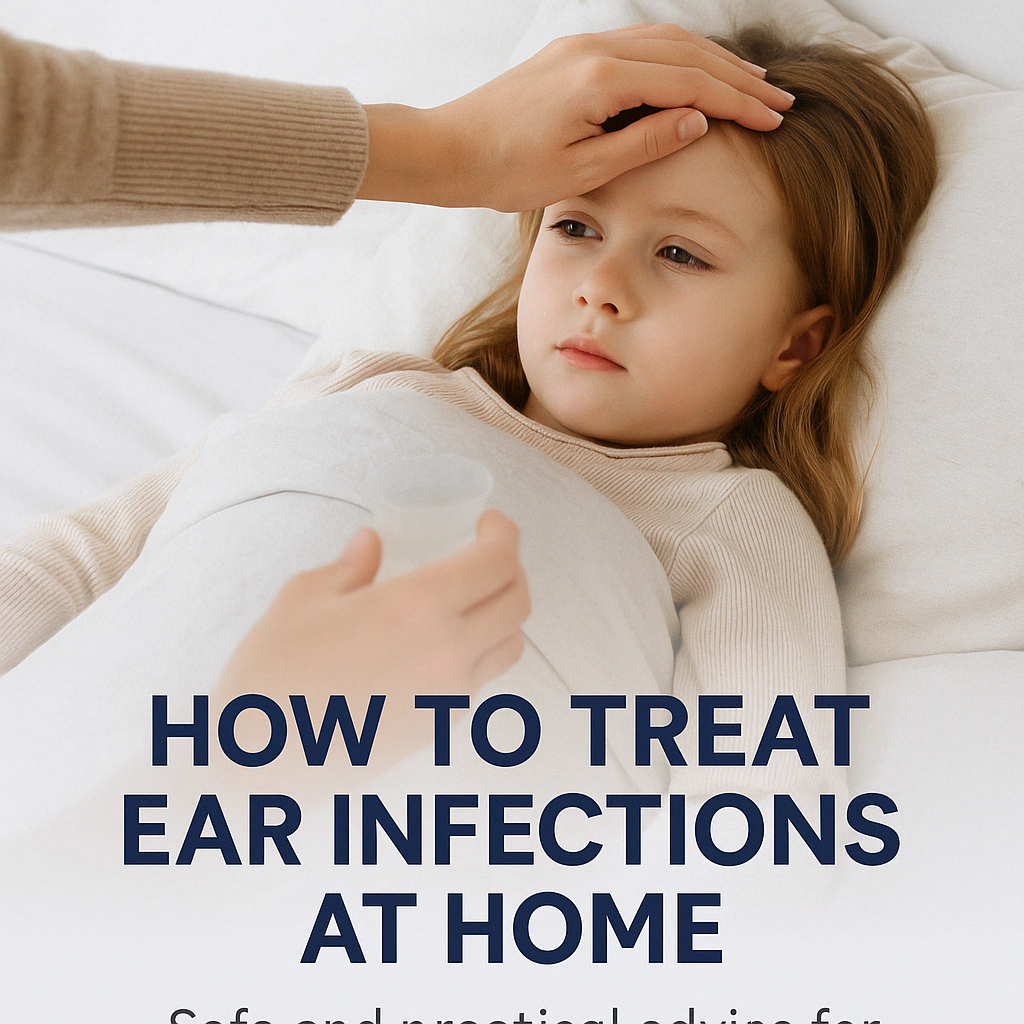

Introduction – treat ear infections at home
Treat ear infections at home – Ear infections are among the most common reasons Canadian children visit doctors. For many parents, the first sign is a fussy, crying child who tugs at their ear or struggles to sleep. While some cases require antibiotics or medical attention, many mild ear infections can be treated safely at home using evidence-based methods.
This article offers practical advice for parents who want to understand the causes of ear infections, recognize symptoms, and know how to manage them effectively without rushing to the clinic.
Treat ear infections at home – What Causes Ear Infections in Children?
An ear infection, or otitis media, is typically the result of bacteria or viruses that infect the space behind the eardrum. This can cause inflammation and fluid buildup, leading to discomfort and pain.
👶 Common causes include ( Treat ear infections at home ) :
- A recent cold or upper respiratory infection
- Allergies that cause nasal congestion
- Bottle-feeding while lying flat
- Underdeveloped Eustachian tubes in young children
Canadian winters and cold season increase the likelihood of respiratory infections, indirectly raising the risk of ear infections, especially in toddlers and preschoolers.
Treat ear infections at home – Signs and Symptoms of an Ear Infection
Ear infections aren’t always easy to identify, especially in children too young to communicate discomfort. Watch for the following signs:
- Tugging or pulling at the ear
- Fussiness or crying more than usual
- Difficulty sleeping
- Fluid draining from the ear (may be yellow or bloody)
- Fever (especially over 38.5°C)
- Balance issues or clumsiness
- Difficulty hearing or responding to sounds
When to See a Doctor – treat ear infections at home
Not all ear infections need a trip to the doctor. However, seek medical care if:
- The fever exceeds 39°C (102.2°F)
- The symptoms last more than 48 hours
- There is fluid or blood draining from the ear
- Your child has recurrent infections (more than 3 in 6 months)
- Your baby is under 6 months old
In Ontario and other provinces, you can also call Telehealth Ontario or visit a walk-in clinic for quick assessment if you’re unsure.
Treat ear infections at home – Home Treatment Options for Mild Ear Infections
If your child has mild symptoms and no fever, here are safe steps to treat the infection at home:
1. Pain Relief
- Use acetaminophen (Tylenol) or ibuprofen (Advil) as per age-appropriate dosage.
- These medications reduce both pain and fever.
- Do not give aspirin to children due to the risk of Reye’s syndrome.
2. Warm Compress
- Apply a warm cloth or compress to the affected ear for 10–15 minutes.
- This can relieve discomfort without medication.
3. Keep the Head Elevated
- Raise your child’s head slightly when sleeping (if age-appropriate) to allow drainage.
4. Stay Hydrated
- Encourage fluids to help thin mucus and allow better drainage through the Eustachian tubes.
5. Treat ear infections at home – Monitor Symptoms
- Track fever, sleep quality, and pain. If symptoms worsen, call your doctor.
What NOT to Do at Home – treat ear infections at home
Avoid these common mistakes when dealing with an ear infection:
- ❌ Do not use cotton swabs or insert anything into the ear canal
- ❌ Avoid overusing antibiotics if your child has viral symptoms
- ❌ Don’t wait more than 2 days if symptoms are severe or worsening
Treat ear infections at home – How Long Do Ear Infections Last?
With or without treatment, most ear infections resolve within 2 to 3 days. Full fluid drainage from the ear may take a week or longer.
In some cases, a healthcare provider may recommend antibiotics, especially if the infection is bacterial and doesn’t improve.
Can You Prevent Ear Infections?
While not always avoidable, you can reduce your child’s risk by:
- Keeping up-to-date with vaccinations (like pneumococcal and flu shots)
- Avoiding secondhand smoke exposure
- Feeding your baby upright, especially with bottles
- Encouraging regular hand washing to avoid colds
Helpful Canadian Resources
Internal Link
Explore also: How to Reduce Fever in Children
Conclusion
Ear infections are painful but often manageable at home, especially when caught early and monitored carefully. Using over-the-counter medications, warm compresses, and proper care, many children can recover comfortably without a doctor visit. That said, always trust your instincts — and if symptoms worsen, seek help immediately.
Disclaimer
This article is intended for educational purposes only and does not replace medical advice. Consult a licensed healthcare provider for any concerns about your child’s symptoms.
👉 Want more expert care and health tips from trusted sources? Check Here.
Pingback: Identifying Skin Rashes in Toddlers - Maple Medica